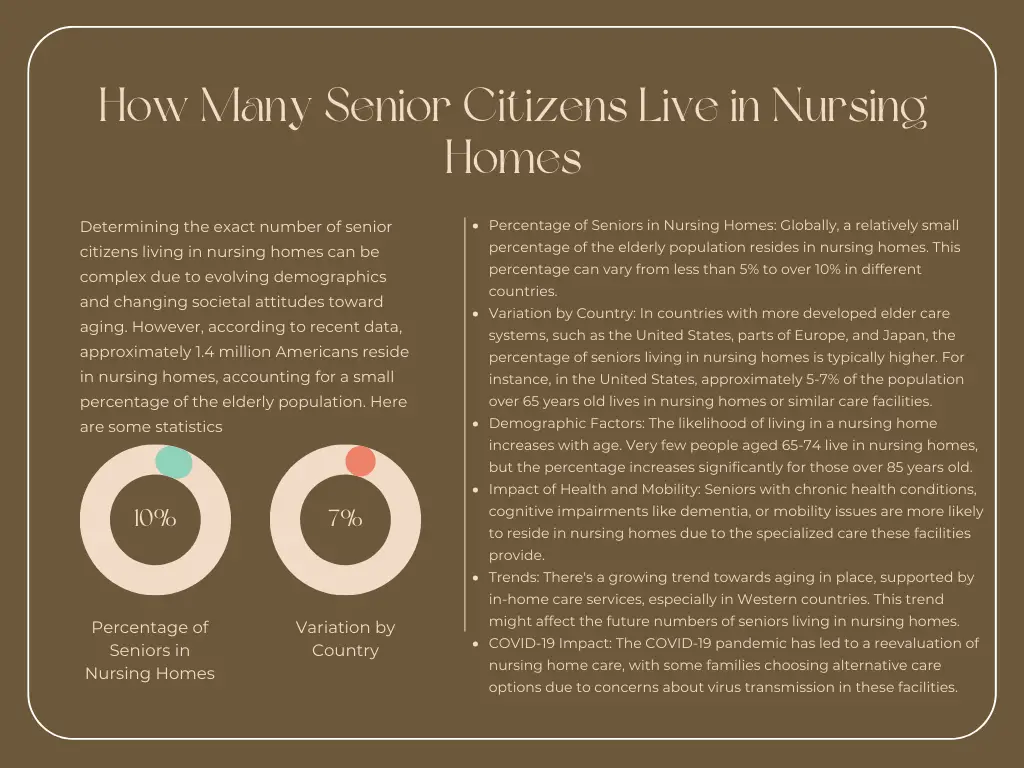As the population ages, the demand for senior care services continues to grow. One prominent option for elderly individuals who require assistance with daily activities is residing in nursing homes. This article delves into the world of nursing homes, exploring their purpose, the demographics they serve, and the vital role they play in the lives of senior citizens.
What Is a Nursing Home?
Nursing homes, also known as skilled nursing facilities or convalescent homes, are residential facilities that provide 24-hour healthcare services to individuals who may be unable to care for themselves independently. These facilities cater to seniors with various medical needs, offering assistance with activities of daily living, medical monitoring, and rehabilitation services.
Who Do Nursing Homes Serve?
Nursing homes serve a diverse population of elderly individuals, including those with chronic illnesses, disabilities, or cognitive impairments. Seniors who require specialized medical care, such as those recovering from surgery or managing chronic conditions like Alzheimer’s or Parkinson’s disease, often find the support they need in nursing homes.
Nursing Home Reputations
The reputation of nursing homes varies widely, with some facilities excelling in providing compassionate and high-quality care while others face challenges related to issues like understaffing and inadequate resources. Families and seniors often consider factors such as staff-to-resident ratios, cleanliness, and the availability of recreational activities when choosing a nursing home.
How Many Senior Citizens Live in Nursing Homes

Determining the exact number of senior citizens living in nursing homes can be complex due to evolving demographics and changing societal attitudes toward aging. However, according to recent data, approximately 1.4 million Americans reside in nursing homes, accounting for a small percentage of the elderly population. Here are some statistics:
- Percentage of Seniors in Nursing Homes: Globally, a relatively small percentage of the elderly population resides in nursing homes. This percentage can vary from less than 5% to over 10% in different countries.
- Variation by Country: In countries with more developed elder care systems, such as the United States, parts of Europe, and Japan, the percentage of seniors living in nursing homes is typically higher. For instance, in the United States, approximately 5-7% of the population over 65 years old lives in nursing homes or similar care facilities.
- Demographic Factors: The likelihood of living in a nursing home increases with age. Very few people aged 65-74 live in nursing homes, but the percentage increases significantly for those over 85 years old.
- Impact of Health and Mobility: Seniors with chronic health conditions, cognitive impairments like dementia, or mobility issues are more likely to reside in nursing homes due to the specialized care these facilities provide.
- Trends: There’s a growing trend towards aging in place, supported by in-home care services, especially in Western countries. This trend might affect the future numbers of seniors living in nursing homes.
- COVID-19 Impact: The COVID-19 pandemic has led to a reevaluation of nursing home care, with some families choosing alternative care options due to concerns about virus transmission in these facilities.
It’s important to note that these statistics are general and the actual numbers can vary. For the most current and specific data, it’s best to consult reports from health departments, senior care organizations, or census data from the relevant country or region.
The Importance of Nursing Homes for Seniors
Despite being a relatively small percentage of the senior population, nursing homes play a crucial role in providing specialized care and support for those with complex medical needs. These facilities offer a secure environment with trained staff, medical supervision, and rehabilitative services, contributing to the overall well-being of residents. For seniors with advanced healthcare needs, nursing homes can provide a level of care that may be challenging to replicate in other settings.
Conclusion
In conclusion, nursing homes are essential institutions that serve a specific segment of the senior population, offering specialized care and support for those with complex medical needs. While the number of senior citizens residing in nursing homes is a fraction of the overall aging population, these facilities provide vital services that contribute to the health and quality of life for many elderly individuals. As society continues to address the evolving needs of its aging population, understanding the role and importance of nursing homes remains crucial in ensuring the well-being of seniors in our communities.

Morgan Elfman is a compassionate writer, dedicated caregiver, and passionate advocate for senior well-being. Born and raised with a deep sense of empathy and a natural inclination towards service, Morgan has devoted her life to making a positive impact on the lives of seniors.
As a writer for www.choiceseniorlife.com, Morgan utilizes his skills to create insightful and informative content that addresses the unique needs and challenges faced by seniors and their families. Her articles not only provide valuable information on health, lifestyle, and care options but also strive to inspire and empower seniors to lead fulfilling lives.

